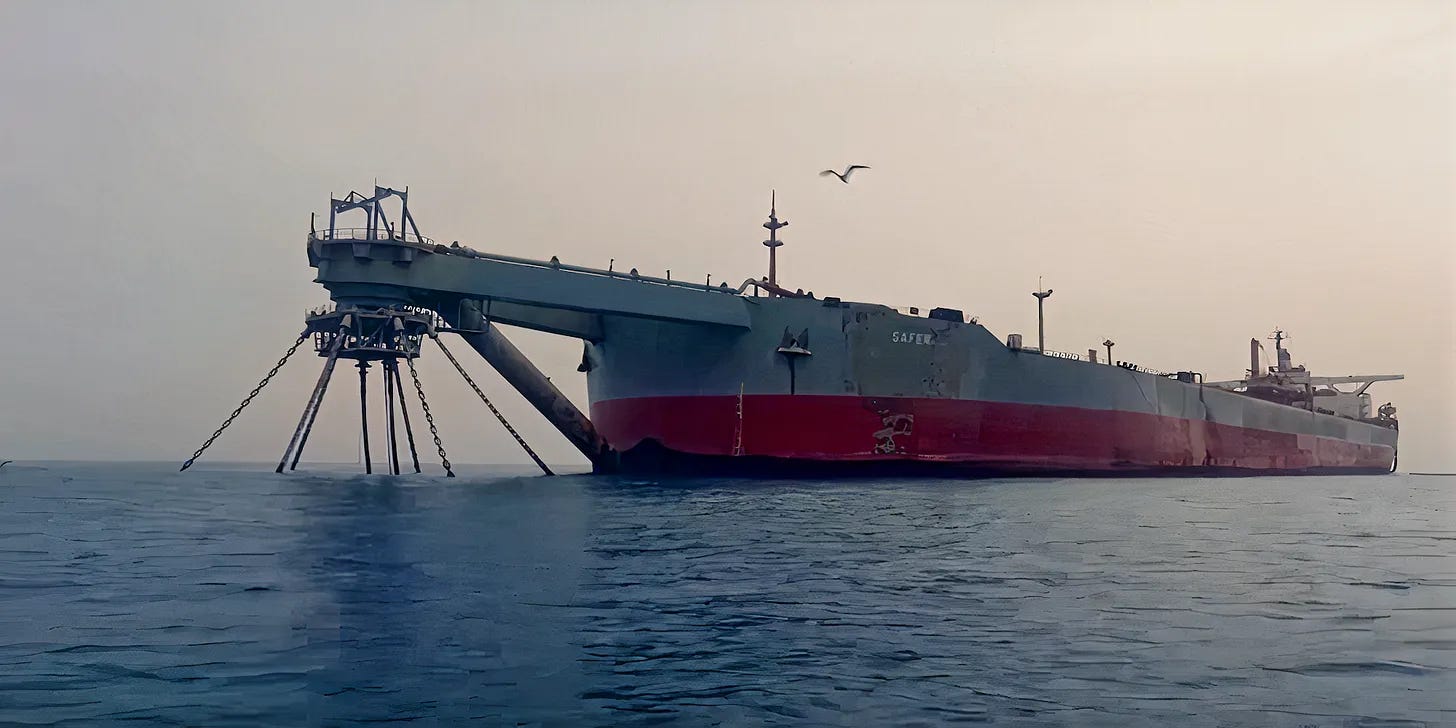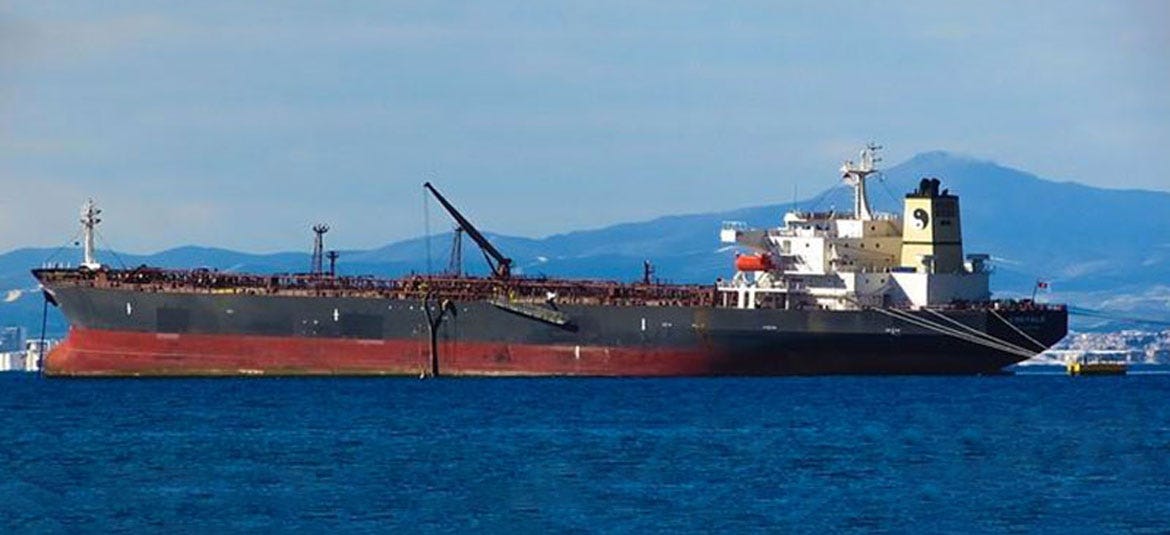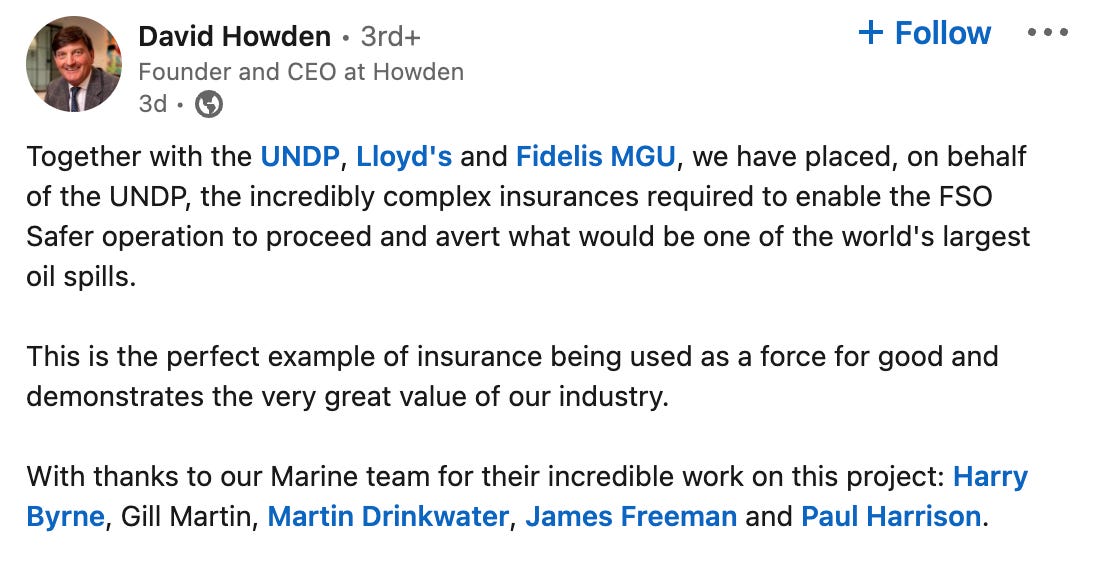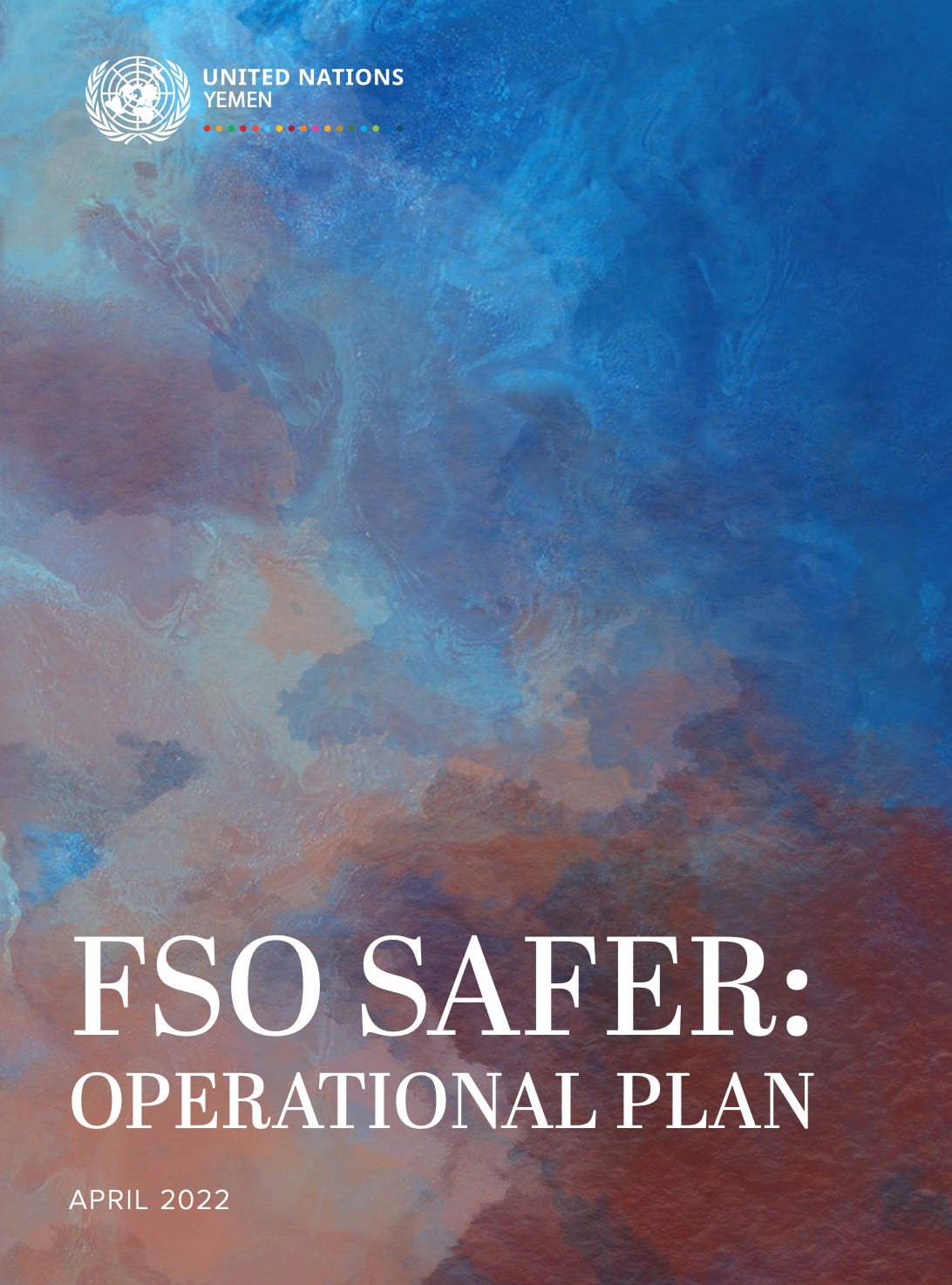FSO Safer: Insurance and operational risks recap
Coverage now in force for the ship-to-ship oil transfer and the recipient Nautica
Insurance is secured for the FSO Safer rescue plan
During a UN press conference on 30 May, UNDP Administrator Achim Steiner revealed that amongst the many items the UNDP had to cover off to successfully implement the Operational Plan, insurance had been a key element to be finalised.
And to that end he was happy to announce that around midnight of Friday the 26th, negotiations between the UNDP, the insurance brokers Howden Group and a consortium of underwriters had been successfully completed. As a direct result, the SMIT support ship, Ndeavor, was given the go ahead to depart Djibouti a couple of days later for the one-day journey to the port of Ras Isa where the Safer is located.
Nearly two weeks later on 12 June the UNDP announced that insurance cover had binded for the ship-to-ship transfer of oil from the Safer to the Nautica, the recycling of the Safer and the replacement Nautica itself, which is another a way of saying insurance coverage was now in force.
The insurance situation when the Operational Plan was released
A main consequence of the Safer not having been available for inspections since 2015 is that the American Bureau of Shipping withdrew all of its relevant certificates (such as for seaworthiness) and so it became uninsurable.
Being uninsured meant that any resulting costs from an oil spill or leak would not be covered financially. Therefore, before any type of oil transfer operation could commence, insurance would need to be in place.
When the UNDP Operational Plan was released in April 2023, the question of insurance was addressed:
The UNDP, being responsible for project managing the rescue plan, would need to contract the requisite insurance, along with the leasing of the replacement vessel, its crew and maintenance. This was flagged as part of the “preparatory works” phase of the operation, before SMIT would begin their detailed planning and preparation, itself right before approaching the Safer.
The question of liability was raised in relation to the ship-to-ship (STS) transfer of oil and later storage, including clarity in case of spillage during the former stage. Both SMIT and the UNDP were to seek legal advice on this. The Plan commented that normally this would be covered by insurance, which the Safer does not have, concluding that “[a] RACI4 will be set up to show liability on the insurance during STS and storage”.
When it came to the broad Budget outlined for the operation, two line items were dedicated to the topic of insurance under the emergency phase (i.e. the period before the permanent vessel was to be secured):
“Insurance machinery and hull” - USD 1,944,000
“Insurance crude cargo” - USD 1,680,000
What we do know about how insurance coverage was achieved
The UK-based Howden Group, led by CEO and Founder David Howden, was appointed the UNDP’s insurance broker in open tender. In an article for the Sunday Times, business reporter Laith Al-Khalaf outlines some of the details behind the Howden Group’s role:
David Howden had been working on this for six months, which would suggest that the appointment commenced around December of last year.
Along with his team, as well as advisers from the UNDP (including from their Insurance and Risk Finance Facility), Howden set about laying out an insurance rescue plan.
Key to his plan was to convince underwriters to insure the operation and so he started by setting up a comprehensive risk assessment, which involved 100 underwriters, which would demonstrate that all risks had been identified so that they could be factored into their premiums.
His company “worked with naval architects, salvage experts and engineers, many of whom deployed deep sea divers to photograph the rusty vessel, to evaluate the risks”.
In addition, it “also added provisions to de-risk the operation, such as the deployment of Yemeni coast guards to monitor mines laid in the waters during the years of war”.
The process involved many late nights and no doubt sleepless ones too because, as Howden noted: “What we are doing here is unprecedented in its complexity. I have been in insurance for 43 years and it’s undoubtedly one of the most complicated risks I have seen underwritten.” He later reiterated the complexity in a post on LinkedIn after the UNDP announcement:
In the end according to the UNDP announcement, Howden “packaged, structured and then syndicated the various risks across thirteen insurers in the Lloyd’s, London and P&I markets”; the lead underwriter was Fidelis MGU.
The Insurer interviewed David Stander, an adviser to the UNDP, and summarised the reasons why he also found it to be one of the most complex policies he had ever seen:
There were a lot of people involved in the process working all hours - “engineers, naval architects, chemists, surveyors, salvage specialists, lawyers” - along with the aforementioned 100 underwriters.
The rescue operation was taking place in a Joint War Committee area of ‘high risk’.
There were a lot of insurance product lines - “hull and machinery, war, pollution, cargo, P&I and crew” across different markets and capital providers.
Finalising the intricacies of the policy fine print went through many drafts.
The matter was urgent and under the glare of attention from the media and donors.
And yet! “[O]nce the risks had been packaged up and the program structured, the placement process itself was wrapped up in just a couple of weeks,” he said.
What we don’t know about the insurance deal
The cost of insurance
While the emergency plan had set aside $3,624,000 for insurance for the 18- month operation, no price tag has been revealed for the announced insurance policies.
The duration of the insurance
The emergency plan was set to last for 18 months until a permanent vessel was sourced. While that plan was scrapped due to the cost of tankers and lack of leasable vessels, it is not clear what the plan was for the longer term. The Nautica is set to be part of the coverage, but how long the current policy lasts is not clear.
Who will be responsible for insurance long-term
In the Sunday Times article referenced above, it was noted that in March of this year, the UNDP actually ‘bought’ the Safer from the Yemen oil company SEPOC in some kind of swap; during the ship-to-ship oil transfer there will be a “one second ‘flash sale’” of the Nautica to SEPOC.
With the port of Ras Isa and the Safer under the control of the Houthis, who are the de facto authorities in the region, this means that the Nautica de facto belongs to the Houthis as well.
Therefore, what terms and conditions are in place for the recognition of the above current reality, is an important question which is yet to be answered.
What if there are delays to the operation?
Operational
If a technical difficulty arises, or unsafe conditions are revealed, there is a real possibility that the mission could be halted for an undetermined period of time. Who would cover necessary expenses arising from this? Is this part of a separate arrangement with SMIT? What if the UNDP budget needs to be expanded? Is this part of the insurance package?
Political
While all parties seem to be committed to the process at this stage, it has been a very long and bumpy road to this point, with delays and accusations of politics being played over a potentially disastrous oil spill. What if the operation is delayed because of these factors? Is this covered at all?
The main risks identified in the Operational Plan
Another thing which Achim Steiner flagged during that press conference was that while insurance had been able to financially de-risk many elements of the operation, there were others which it was not possible to do so for.
While any insurance policy will not cover everything (or the underlying insurers will not offer policies for certain items), it is worth also summarising all of the risks and issues identified in the Plan, as well as the mitigating measures which are an essential complement to any contracted insurance terms and conditions.
Under the rubric of “Security Arrangements for the emergency operation”, the UNDP outlined the below key risks and mitigation approaches. (As part of its usual procedures, SMIT Salvage/Boskalis also employed the global risk consultancy Control Risks to undertake a threat analysis and security risk assessment; the UN says it also took their conclusions into consideration.)
Managing the overall operating context
The FSO Safer is moored in an area controlled by the Houthis or the “De Facto Authorities” as they are now also referred to, and so the emergency operation needs to inescapably comply with their dictates.
The UNDP noted that the frontline of the conflict had moved south of the Hodeidah governate post mid-November 2021 and so from a conflict perspective at least the area is less volatile.
Various UN agencies already operate in the region, have existing working relationships with the Houthis and established procedures for dealing with the group. In addition, during the operation a dedicated liaison officer will be deployed to manage relations between the UN, the Houthis and SMIT Salvage.
The UNDP will also undertake regular political analysis to keep their operations current to local conditions.
From a broader Yemen perspective, the UN said they engaged all of the relevant stakeholders to get their support for the operation, including the Houthis, the internationally recognised Yemen government and the Saudi-led Coalition.
Regular agreed operating procedures
Security protocols would need to be agreed with the Houthis for the operation, including who can carry weapons near the Safer operation, that weapons would not be allowed on the Safer itself and that all equipment on board must be intrinsically safe.
The Yemeni CoastGuard, as career professionals, would play an important and hoped for neutral part in the operation .
The UN would be responsible for the ‘de-confliction’ of the operating area, including through normal procedures with Saudi Arabia.
Managing the day-to-day operating environment
A point brought up by Control Risks was that SMIT were operating in an unfamiliar and conflict-ridden environment, with the possibility of tensions arising from misunderstandings due to required but unplanned changes in operational plans.
Two solutions were put forward:
The best SMIT team for this particular environment would need to be secured, skilled in diplomacy and trained in cultural awareness.
If issues did arrive they would need to be handled appropriately, making regular liaisons with the Houthis ever more important. The UN Liaison officer would be key to setting up lines of communication; a liaison person would also be provided by the Fahem Group, who were an important part of setting up the agreement with the Houthis which ultimately lead to this operation.
Travel, accommodation and emergency medical facilities
Travel to and from the operation would be in armoured UN vehicles, with a UN security officer on board. The routes between Sana’a and Hodeidah, and to/from Ras Isa port is well travelled by UN staff, but road movements would need to be communicated with the Houthis.
Staff would stay in UN guesthouses and be subject to regular UN procedures.
Basic medical clinics would be upgraded to suit SMIT’s medical provider, with transport via armoured ambulances on tarmac road all the way to Sana’a. In the capital, arrangements with a flying doctor service to Nairobi, Kenya were in place; the UNMHA (UN Mission to support the Hudaydah Agreement) also had a helicopter in Djibouti just in case.
Dealing with risks associated with the vessel and salvage operation
The responsibility would sit with the highly experienced SMIT and their usual operational procedures.
The ship-to-ship transfer would be done based on guidelines from the International Chamber of Shipping in the Guide for Petroleum, Chemicals and Liquefied Gas.
The transfer would be done independently of the Safer’s decaying cargo handling and safety systems, using specialist equipment.
The clean-up part of the operation, including de-mucking, washing and scrubbing of each of the storage tanks, and the handling of any remaining gases, would mitigate risks of explosions.
Maritime hazards
Sea-Mines (Likelihood LOW, Impact VERY HIGH)
These are known to drift in the surrounding waters depending on the time of the year and known currents.
For support vessels approaching the Safer and when the Safer eventually departs, the idea is to use routes maintained by existing commercial shipping vessels, after a ‘break-through operation’ is conducted in line with procedures usually conducted in sea mined areas.
IEDs (Likelihood VERY LOW, Impact VERY HIGH)
The existence of IEDs on board the Safer was considered very low, but a counter-IED expert was available if required.
Limpet-Mines (Likelihood VERY LOW, Impact VERY HIGH)
Similar to IEDs, this was considered a very low risk.
Water-Borne IEDs (Likelihood VERY LOW, Impact VERY HIGH)
This risk was going to be handled with the Houthis, with security patrols mitigating any risks
Land Hazards
Landmines (Likelihood VERY LOW, Impact HIGH)
To mitigate these risks, only known routes, swept of landmines, would be used; personnel would be instructed to stay on main roads.







